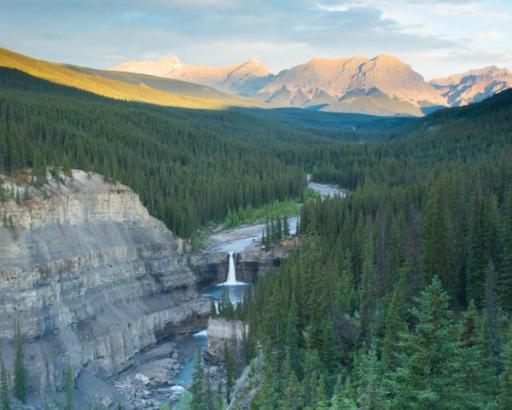December 15, 2016
Protecting the Bighorn as a Wildland Park

By Hilary Young, Y2Y
Long before I started working with Y2Y, I’d heard about the allure of the Bighorn Wildland – especially the cold, clear tributaries and waterfalls that form the headwaters of the North Saskatchewan River. I was excited to experience this landscape firsthand with my colleagues over the summer, as one of Y2Y’s major goals is to protect the Bighorn as a Wildland Park.
We started out on the trail to the Siffleur Falls, crossing a long suspension bridge and a wooden boardwalk before gaining elevation on the limestone hills. Four kilometers passed quickly, and we were caught by surprise when the trail narrowed and the limestone suddenly cut away into the sloping Siffleur Canyon.
When we came upon the cascading falls a few hundred meters further, we sat for a while in awe, gaining perspective on the steady natural forces that pre-date humans by just staring thoughtfully into the river canyon. For how many hundreds of thousands of years has clean, quick-flowing water been wearing away rock? And for what tiny fraction of this have we been meddling with natural processes and having a disproportionate impact?
After taking photos (which of course failed to capture the emotional experience the canyon evoked in person), we started our hike back out. I knew that the Siffleur River flowed into the North Saskatchewan and then into the Edmonton Capital Region’s water supply. I knew that these tributaries lay within an intact landscape that provided quality habitat for threatened species like grizzlies. But getting out into the Bighorn gave me an emotional connection to a place I could recite facts about — I now understood on a more visceral level that industrial resource extraction and motorized recreational vehicles had no place here. The ancient canyon was the perfect symbol for wild lands that have a timeline, purpose and rhythm well beyond our own.
The Bighorn Wildland that lies between Jasper and Banff National Parks needs to be protected as a Wildland Park. This vast landscape of low elevation foothills, broad valley bottoms, ridgelines and mountains is part of the interconnected Yellowstone to Yukon region, one of the last intact mountain ecosystems left on Earth. Over a million Albertans downstream of the Bighorn, in places like Edmonton and Clearwater County, rely on the water that its tributaries and rivers provide.
Please help protect these lands by calling or writing your local MLA to let them know you want the Bighorn to be designated a Wildand Park! Visit us at loveyourheadwaters.ca for more information.
Topic


